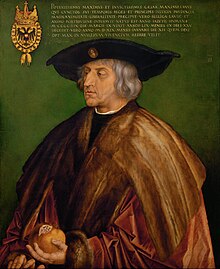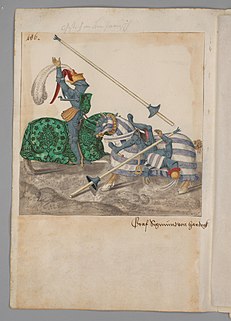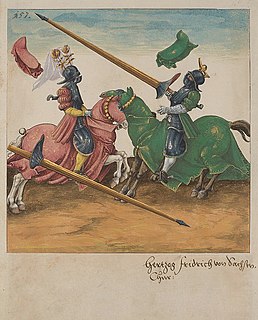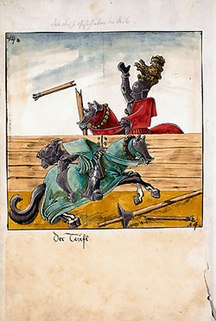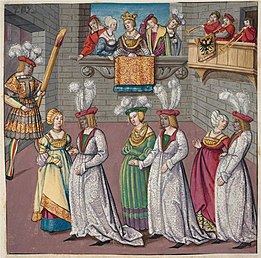
Maximilian I was King of the Romans from 1486 and Holy Roman Emperor from 1508 until his death in 1519. He was never crowned by the Pope, as the journey to Rome was blocked by the Venetians. He proclaimed himself elected emperor in 1508 at Trent, thus breaking the long tradition of requiring a papal coronation for the adoption of the Imperial title. Maximilian was the only surviving son of Frederick III, Holy Roman Emperor, and Eleanor of Portugal. Since his coronation as King of the Romans in 1486, he ran a double government, or Doppelregierung, with his father until Frederick's death in 1493.
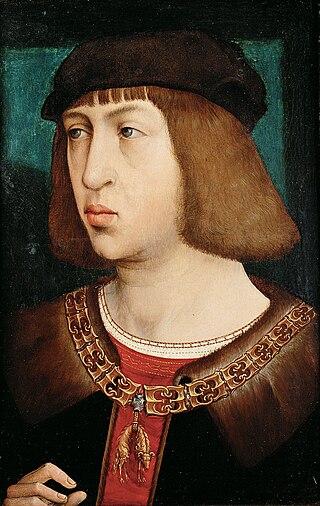
Philip the Handsome, also called the Fair, was ruler of the Burgundian Netherlands and titular Duke of Burgundy from 1482 to 1506, as well as the first Habsburg King of Castile for a brief time in 1506.

Mary of Burgundy, nicknamed the Rich, was a member of the House of Valois-Burgundy who ruled a collection of states that included the duchies of Limburg, Brabant, Luxembourg, the counties of Namur, Holland, Hainaut and other territories, from 1477 until her death in 1482.

Jousting is a medieval and renaissance martial game or hastilude between two combatants either on horse or on foot. The joust became an iconic characteristic of the knight in Romantic medievalism.

Bianca Maria Sforza was Queen of Germany and Empress of the Holy Roman Empire as the third spouse of Maximilian I. She was the eldest legitimate daughter of Duke Galeazzo Maria Sforza of Milan by his second wife, Bona of Savoy.

Hans Burgkmair the Elder (1473–1531) was a German painter and woodcut printmaker.

The Vienna Coronation Gospels, also known simply as the Coronation Gospels, is a late 8th century illuminated gospel book produced at the court of Charlemagne in Aachen. It was used by the future emperor at his coronation on Christmas Day 800, when he placed three fingers of his right hand on the first page of the Gospel of Saint John and took his oath. Traditionally, it is considered to be the same manuscript that was found in the tomb of Charlemagne when it was opened in the year 1000 by Emperor Otto III. The Coronation Evangeliar cover was created by Hans von Reutlingen, c. 1500. The Coronation Evangeliar is part of the Imperial Treasury (Schatzkammer) in the Hofburg Palace in Vienna, Austria.

Maximilian armour is a modern term applied to the style of early 16th-century German plate armour associated with, and possibly first made for the Emperor Maximilian I. The armour is still white armour, made in plain steel, but it is decorated with many flutings that may also have played a role in deflecting the points and blades of assailants and increasing the structural strength of the plates. It is a transitional stage in the decoration of armour, after the plain steel surfaces of 15th-century armour and before the elaborate decoration and colouring with etching and other techniques of Renaissance armour. The armour is characterized by armets and close helmets with bellows visors; small fan-shaped narrow and parallel fluting—often covering most of the harness ; etching; work taken from woodcuts; sharply waisted cuirasses, and squared sabatons.

Ambras Castle is a Renaissance castle and palace located in the hills above Innsbruck, Austria. Ambras Castle is 632 metres (2,073 ft) above sea level. Considered one of the most popular tourist attractions of the Tyrol, Ambras Castle was built in the 16th century on the spot of an earlier 10th-century castle, which became the seat of power for the Counts of Andechs. The cultural and historical importance of the castle is closely connected with Archduke Ferdinand II (1529–1595) and served as his family's residence from 1567 to 1595. Ferdinand was one of history's most prominent collectors of art. The princely sovereign of Tyrol, son of Emperor Ferdinand I, ordered that the medieval fortress at Ambras be turned into a Renaissance castle as a gift for his wife Philippine Welser. The cultured humanist from the House of Habsburg accommodated his world-famous collections in a museum: the collections, still in the Lower Castle built specifically for that museum's purpose, make Ambras Castle one of the oldest museums in the world.

The Triumphal Arch is a 16th-century monumental woodcut print commissioned by the Holy Roman Emperor Maximilian I. The composite image was printed on 36 large sheets of paper from 195 separate wood blocks. At 295 × 357 centimetres (116 × 141 in), it is one of the largest prints ever produced and was intended to be pasted to walls in city halls or the palaces of princes. It is a part of a series of three huge prints created for Maximilian, the others being a Triumphal Procession which is led by a Large Triumphal Carriage ; only the Arch was completed in Maximilian's lifetime and distributed as propaganda, as he intended. Together, this series has been described by art historian Hyatt Mayor as "Maximilian's program of paper grandeur". They stand alongside two published biographical allegories in verse, the Theuerdank and Weisskunig, heavily illustrated with woodcuts.

Giuseppe Arcimboldo, also spelled Arcimboldi, was an Italian painter best known for creating imaginative portrait heads made entirely of objects such as fruits, vegetables, flowers, fish and books.

The Triumphal Procession or Triumphs of Maximilian is a monumental 16th-century series of woodcut prints by several artists, commissioned by the Holy Roman Emperor Maximilian I. The composite image was printed from over 130 separate wood blocks; a total of 139 are known. Approximately 54 metres (177 ft) long, it is one of the largest prints ever produced. It was designed to be pasted to the walls in city halls or the palaces of princes to create a decorative frieze, an expression of the Emperor's power and magnificence: a pictorial form of the contemporaneous royal entry, which like many Renaissance entries looked back to the Roman triumph. Maximilian's papers show that he intended the procession to "grace the walls of council chambers and great halls of the empire, proclaiming for posterity the noble aims of their erstwhile ruler". It was one of several works of propaganda in literary and print form commissioned by Maximilian, who was always drastically short of money, and lacked the funds to actually stage such a ceremony, unlike his Habsburg descendants. It could also be bound as a book, and it is copies treated this way which have survived, as well as those from later reprints.

The Large Triumphal Carriage or Great Triumphal Car is a large 16th-century woodcut print by Albrecht Dürer, commissioned by the Holy Roman Emperor Maximilian I. The work was originally intended to be the central part of a 54 metres (177 ft) long print of a Triumphal Procession or Triumph of Maximilian, depicting Maximilian and his court entourage in a procession. This section shows the emperor in his triumphal car, and was part of a tradition depicting imaginary "triumphs" or real processions, such as royal entries.
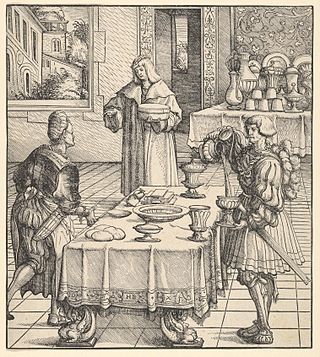
Der Weisskunig or The White King is a chivalric novel and thinly disguised biography of the Holy Roman Emperor, Maximilian I, (1486–1519) written in German by Maximilian and his secretary between 1505 and 1516. Although not explicitly identified as such in the book, Maximilian appears as the "young" White King, with his father Frederick III represented as the "old" White King.
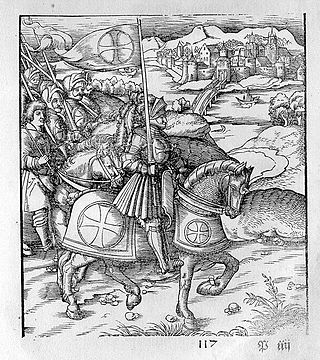
Theuerdank is a poetic work the composition of which is attributed to the Holy Roman Emperor, Maximilian I (1486-1519). Written in German, it tells the fictionalised and romanticised story of Maximilian's journey to marry Mary of Burgundy in 1477. The published poem was accompanied by 118 woodcuts designed by the artists Leonhard Beck, Hans Burgkmair, Hans Schäufelein and others. Its newly designed blackletter typeface was influential.
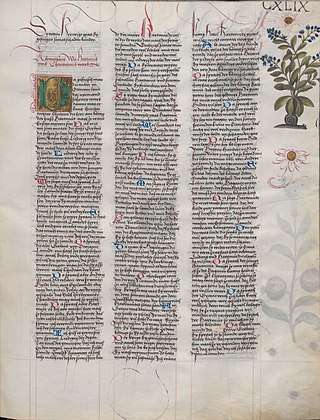
The Ambraser Heldenbuch is a 16th-century manuscript written in Early New High German, now held in the Austrian National Library. It contains a collection of 25 Middle High German courtly and heroic narratives along with some shorter works, all dating from the 12th and 13th centuries. For many of the texts it is the sole surviving source, which makes the manuscript highly significant for the history of German literature. The manuscript also attests to an enduring taste for the poetry of the MHG classical period among the upper classes.

Maximilian I was Holy Roman Emperor from 1508 until his death.
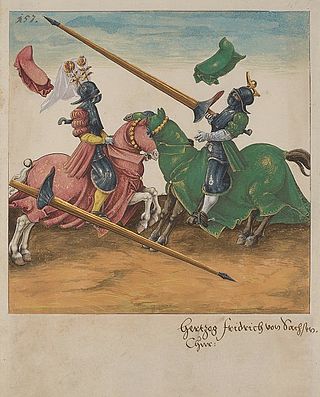
The Freydal tournament book is an early 16th century illuminated manuscript held by the Kunsthistorisches Museum in Vienna containing 255 miniature paintings depicting scenes from a series of imaginary late medieval jousting tournaments. It was created by the court painters of the Holy Roman Emperor, Maximilian I with the intention that the miniatures would be used to illustrate one of the Emperor's "memorial" projects, a prose narrative to be called Freydal. The latter work was never completed in the form Maximilian intended, but the tournament book is one of three surviving elements of the project. The other two are a draft text of the narrative and over 200 drawings created as planning sketches for the miniatures in the tournament book.
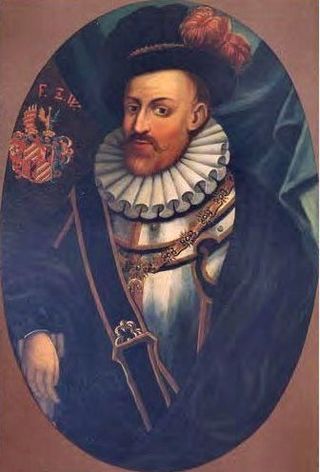
Wolfgang von Polheim (1458–1512), Lord of Polheim zu Wartenburg, Puchheim and Waldenfels, was an Austrian nobleman who was a close and life-long friend and counsellor of the Holy Roman Emperor, Maximilian I. He was given senior positions in the Habsburg administration in Austria and was closely involved in Maximilian's diplomatic initiatives abroad. In 1490, he represented Maximilian at his proxy wedding to Anne of Brittany at Rennes.

Antonio de Caldonazzo, Baron of Ivano, also known as Anton von Yfan, was a nobleman from the northern Italian region of South Tyrol. He was a favourite of the Holy Roman Emperor, Maximilian I and a noted participant in jousts at tournaments. He appears prominently, in a jousting context, in two works of art commissioned by Maximilian: the monumental woodcut, the Triumphal Procession, and in some of the miniature paintings of the Freydal tournament book.

